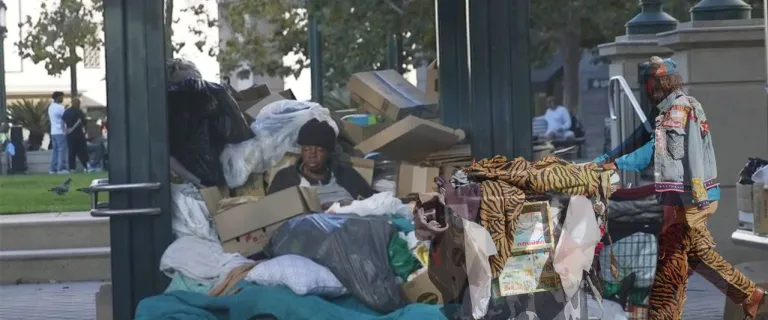 We’ve been watching our California dream degrade with increased crime, homelessness, and substance abuse. Many of these issues have been proliferated by policies from the State Public Safety Committees. The leadership of the Public Safety Committee has blocked legislation authored by both sides of the aisle, resulting in inaction on critical issues like fentanyl. Recently, the media has brought this issue to light. Now, our leaders in Sacramento have agreed to hold a special Assembly Public Safety Committee to listen to the problems related to fentanyl. I applaud these efforts and encourage our elected officials to act on behalf of crime victims.
We’ve been watching our California dream degrade with increased crime, homelessness, and substance abuse. Many of these issues have been proliferated by policies from the State Public Safety Committees. The leadership of the Public Safety Committee has blocked legislation authored by both sides of the aisle, resulting in inaction on critical issues like fentanyl. Recently, the media has brought this issue to light. Now, our leaders in Sacramento have agreed to hold a special Assembly Public Safety Committee to listen to the problems related to fentanyl. I applaud these efforts and encourage our elected officials to act on behalf of crime victims.
We’ve seen violent crime increase throughout California and the Inland Empire. Many of these issues are related to misguided legislative priorities from our politicians in Sacramento. Proposition 47, “The Safe Neighborhoods and Schools Act,” increased the felony threshold rate for theft in retail establishments to over $950, decriminalized drug possession, and contributed to our growing homeless population.
In San Bernardino County, our Homeless Outreach and Proactive Enforcement Team (HOPE) estimated that we have 2,100 homeless individuals who are adverse from help and suffer from extreme mental health and substance abuse issues.
When you consider that it’s more difficult for law enforcement to make arrests, Proposition 57, passed six years ago and reclassified several violent crimes as nonviolent, for example, heinous acts such as human trafficking, domestic violence, and rape of the unconscious person are no longer considered violent crimes under California statutes.
With removing many of the tools that law enforcement utilizes to get criminals off the streets, it’s no wonder we see the issues of violent crime spiking and increased homelessness in our communities. Earlier this year, I reviewed data from the California Department of Corrections and Rehabilitation (CDCR) and found that California currently has 6,987 parolees at large as of December 2022. More specifically, we have 552 parolees at large in San Bernardino County. These at-large parolees are felons who do not comply with their parole agreements’ terms and conditions and are wandering our communities’ streets.
These numbers are concerning because these are parolees and likely the culprits of violent crime. Many of these criminals don’t report addresses. They are either part of the homeless population or live with others because they have warrants for their arrest.
When you see nearly 7,000 criminals roaming the streets, I think the public can understand why we see violent crime spike. In fact, during March, our Deputy Sheriffs have been involved in two lethal force encounters with these parolees at large and violent criminals.
Several calls for service that law enforcement receives are related to mental health issues that our lawmakers must address. While I remain optimistic that there is an appetite for change at the State Capitol, our Deputy Sheriffs consistently receive calls for service for mentally ill residents in our community. Since January 2020, our department has received 16,929 calls for service for mental health crises.
When I speak to various community groups and organizations throughout the County, the residents are concerned about their safety. Our Deputy Sheriffs do a phenomenal job responding to calls for service, but our County is vast, and I always encourage safe and responsible firearm ownership. Since 2019, I have received 12,640 applications for citizens to carry concealed weapons. This number continues to increase by, on average, nearly 30% per year.
Last fall, the San Bernardino County Sheriff’s Department launched Operation Consequences, which focuses on conducting crime suppression operations throughout the County to curb violent crime, dismantle targeted criminal street gangs, and arrest criminals illegally possessing, manufacturing, and trafficking firearms.
Operation Consequences has resulted in over 100 pounds of Fentanyl being taken off the streets, over 450 arrests, and nearly 500 illegal firearms out of the hands of criminals. I can’t thank the Board of Supervisors enough for funding these specialized operations to make a dent in the violent crimes in San Bernardino County.
I encourage the general public to become more active with your Sacramento and Washington, DC legislators. Resources like OpenStates.com allow you to use a website and zip code to find state and federal elected leaders. Learn who your representatives are and call their offices to let them know you are concerned about the safety of your communities.
Shannon Dicus is the 36th Sheriff-Coroner of San Bernardino County, representing over 2 million residents and over 4,000 law enforcement personnel. He is a veteran of the U.S. Army and lives in the San Bernardino County High Desert.

